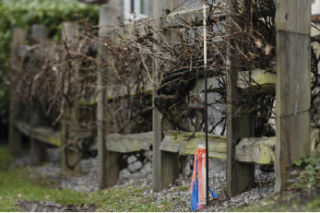Question: Our yard has a rockery along one side and a fence was built at the base. We now want to have the fence along the lot line to gain some landscaping areas, and we need to replace the failing fence on the other sides. Can we build the new fence five feet from the side of the house to place it on the lot line?
Answer: You are best to never assume that a lot line runs parallel to your house or even that the old fence was built on the lot line. Unless a house is newer and the fence was built at the same time as construction, we should assume that the fence may have been constructed where they thought the yard boundary was.
The only way to verify the true lot line is by locating the corner survey markers. These are usually steel stakes driven into the ground and capped with a bright red or yellow listing the surveyor who set them. Newer homes may have a lead pin set into the street or sidewalk marking one corner, but older homes usually require a survey.
The typical charge for a survey marking the four corners costs about $1,000. This may vary if you have an irregular lot that drops into a ravine or is not a rectangular shape.
If you have had an addition to your house or one of your neighbors has rebuilt, you may be able to locate the survey stakes that the city would have required as part of the permit process. If you know or suspect that stakes have been placed, try renting a metal detector to help locate them. You can use these stakes and a very long tape measure (also available at rental yards) to locate your own corners.
With the costs of a fence these days and the possibility of your neighbors disputing its new location, a survey for a fence can make for good neighbors.
Fences
Fences can be 72 inches (six feet) maximum in height, as measured from the top of the fence and post to the ground directly below the fence.
The maximum height is 42 inches (three and a half feet) within 20 feet of the right of way or street, to allow traffic visibility; however, there is a process for height deviation through the city.
Barbed wire and electric fences are prohibited, and cyclone fences should be.
Steve Bryan owns Home and Building Services, Inc. and is an Island resident.



